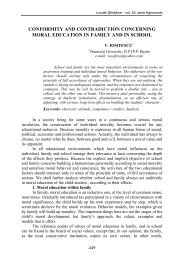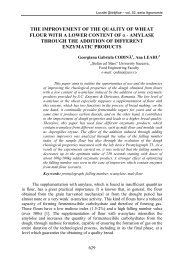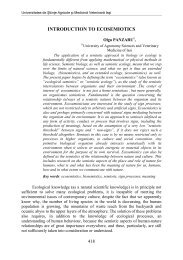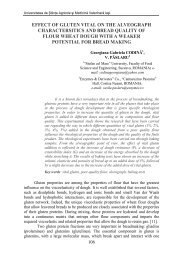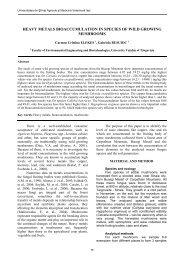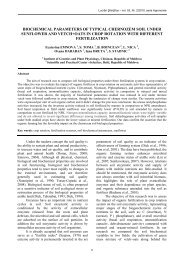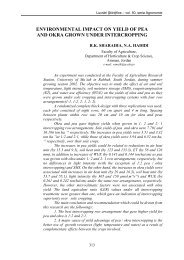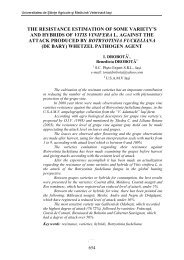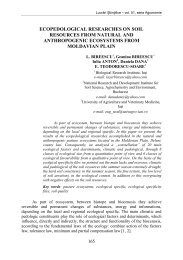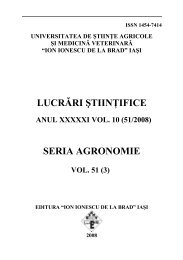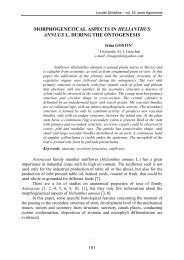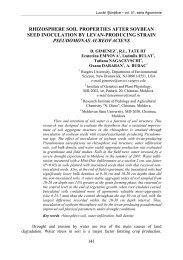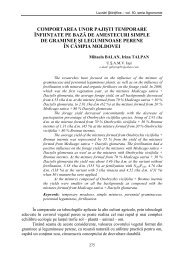selection of bread wheat varieties for organic farming, baking quality ...
selection of bread wheat varieties for organic farming, baking quality ...
selection of bread wheat varieties for organic farming, baking quality ...
You also want an ePaper? Increase the reach of your titles
YUMPU automatically turns print PDFs into web optimized ePapers that Google loves.
Lucrări Ştiinţifice – vol. 51, seria Agronomie<br />
Organic (low-input) <strong>farming</strong> system is described as a <strong>farming</strong> system<br />
connected with a limited amount <strong>of</strong> nutrients (nitrogen especially) and absence <strong>of</strong><br />
the split nitrogen application [KÖPKE, 2005]. The early spring ability <strong>of</strong> nitrogen<br />
absorbtion is the main problem <strong>of</strong> growing <strong>of</strong> winter <strong>varieties</strong>; cold soil is<br />
characterized by a low microbial activity. The nutrient mineralization (<strong>of</strong> nitrogen,<br />
especially) is limited in this period [MOUDRÝ, 2003]. The efficient nitrogen<br />
absorbtion is also very important from the point <strong>of</strong> view <strong>of</strong> the <strong>quality</strong> <strong>of</strong> yield and<br />
evolution <strong>of</strong> plants in early stages <strong>of</strong> growth [REENTS, 2002].<br />
Cultivars should there<strong>for</strong>e have the ability to per<strong>for</strong>m under a low input <strong>of</strong><br />
<strong>organic</strong> fertilizers, a good root system, the ability to interact with beneficial soil<br />
microorganisms and to suppress weeds, and the ability to produce a healthy crop<br />
and healthy propagules [LAMERTS van BUEREN et al., 2002, 2003].<br />
Organic yield is about 20-30 % lower than the conventional [MOUDRÝ,<br />
1997; MÄDER et al., 2002; LAMMERTS van BUEREN, 2002]. The <strong>quality</strong> and<br />
stability <strong>of</strong> the yield are the main priorities <strong>for</strong> <strong>organic</strong> <strong>farming</strong> which does not lay<br />
stress on the quantity <strong>of</strong> production. Farmers usually need to grow “reliable“ and<br />
“solid“ <strong>varieties</strong> which are able to tolerate potential fluctuations in the weather and<br />
the potential pressure <strong>of</strong> diseases; they must in any case be able to provide<br />
sufficient yield <strong>of</strong> grains and straw [LAMMERTS van BUEREN, 2002].<br />
The high <strong>baking</strong> <strong>quality</strong> <strong>of</strong> the <strong>organic</strong> <strong>varieties</strong> is characterized by the<br />
proportion and total content <strong>of</strong> crude protein, high value <strong>of</strong> the Zeleny -<br />
sedimentation value, flour binding capacity and flour yield, Falling number and test<br />
weight. The <strong>baking</strong> <strong>quality</strong> <strong>of</strong> <strong>wheat</strong> is a complex feature; the breeding <strong>of</strong> such<br />
<strong>varieties</strong> (to a high <strong>quality</strong>) is a long and difficult process [FOSSATI et al., 2005].<br />
Organic methods <strong>of</strong> <strong>farming</strong> may have negative effects on the technological value,<br />
especially in the case <strong>of</strong> the crucial crude protein content [MOUDÝ & PRUGAR,<br />
2002].<br />
Modern cultivars <strong>of</strong> <strong>wheat</strong> do not satisfy all the requirements and demands<br />
<strong>of</strong> <strong>organic</strong> agriculture. There<strong>for</strong>e, more attention should be given to the breeding <strong>of</strong><br />
specific cultivars adapted to the agronomic conditions on <strong>organic</strong> farms and<br />
complying with the philosophy <strong>of</strong> <strong>organic</strong> <strong>farming</strong> [LAMMERTS van BUEREN,<br />
2002]. Nowadays, new breeding programmes are emerging because the<br />
conventional <strong>varieties</strong> <strong>of</strong> <strong>bread</strong> <strong>wheat</strong> have a very different genetic background<br />
[KUNZ & KARUTZ, 1991]. LAMMERTS van BUEREN et al. [2003] points out<br />
that, in order to avoid the use <strong>of</strong> chemical fertilizers and pesticides in <strong>organic</strong><br />
agriculture, agroecological principles should be applied to enhance the selfregulatory<br />
capacity <strong>of</strong> the agroecosystems. Organic farmers require cultivars that<br />
can be multiplied and grown in the <strong>organic</strong> <strong>farming</strong> system with no undue negative<br />
effect on the health and function <strong>of</strong> the agroecosystem [KUNZ & KARUTZ, 1991].<br />
The aim <strong>of</strong> paper is to identify diferences in <strong>quality</strong> <strong>of</strong> <strong>varieties</strong> recomended<br />
in conventional or <strong>organic</strong> conditions in Austria and showed that the system <strong>of</strong><br />
variety certification in <strong>organic</strong> <strong>farming</strong> should be different from conventional one.<br />
251




